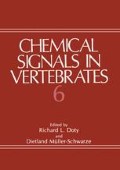Abstract
It has been convincingly demonstrated that mice can discriminate MHC-related odors among congenic strains under laboratory conditions (see Yamaguchi et al. 1981). There is, however, debate about the use of these MHC-related odors as mate choice cues (Partridge, 1988; Klein et al., 1990; Nei and Hughes, 1991). MHC-based mate choice has been postulated to function either to produce presumably more fit MHC heterozygous offspring (Doherty and Zinkernagel, 1975) or to avoid close inbreeding (Brown, 1983). In either case, mating should be disassortative. Data from semi-natural half-wild enclosure studies (Potts et al., 1991) suggest that disassortative matings produce an excess (from random mating expectations) of MHC heterozygous progeny. Behavioral observations also suggest that these disassortative matings are due primarily to female choice. In a subset of 305 pups of known maternity, those in litters of mixed paternity (30 out of 58 litters) show a significant excess of heterozygotes over what would have been produced if females had mated only with their territorial males. Those litters sired only by the female’s territorial male did not deviate from the number of heterozygotes expected. This suggests that an important factor in producing more MHC heterozygous progeny is extra-territorial matings. In 41 observations of mating pairs, all matings took place on the territory of the male. All 13 extra-pair matings observed involved females who had left their nesting territory to travel to the territory of the male with which they were mating. No male was ever observed mating off of his territory. For details see Potts et al. this volume.
Access this chapter
Tax calculation will be finalised at checkout
Purchases are for personal use only
Preview
Unable to display preview. Download preview PDF.
References
Beauchamp, G.K., Yamazaki, K., Bard, J. and Boyse, E.A., 1988, Pre-weaning experience in the control of mating preferences by genes in the major histocompatibility complex of the mouse, Behay. Genet., 18: 537.
Bingel, A.S. and Schwartz, N.B., 1969, Timing of LH release and ovu- lation in the cyclic mouse, J. Reprod. Fertil., 19: 223.
Braden, A.W.H., 1957, The relationship between the diurnal light cycle and the time of ovulation in mice, J. Exp. Biol., 34: 177.
Brown, J.L., 1983, Some paradoxical goals of cells and organisms: the role of the MHC, in: “Ethical questions in brain and behavior”, D.W. Pfaff, ed., Springer Verlag, New York.
D’Udine, B. and Alleva, E., 1983, Early experience and sexual preferences in rodents, in: “Mate choice”, P. Bateson, ed., Cambridge University Press, Cambridge.
Dewsbury, D.A., 1982, Ejaculate cost and male choice, Am. Nat., 119: 601.
Dewsbury, D.A., 1988a, Sperm competition in deer mice (Peromyscus maniculatus bardi) Effects of cycling versus postpartum estrus and delays between matings, Behay. Ecol. Sociobiol., 22: 251.
Dewsbury, D.A., 1988b, Kin discrimination and reproductive behavior in muroid rodents, Behay. Genet., 18: 525.
Doherty, P.C. and Zinkernagel, R.M., 1975, Enhanced immunological surveillance in mice heterozygous at the H-2 gene complex, Nature, 256: 50.
Egid, K. and Brown, J.L., 1989, The major histocompatibility complex and female mating preferences in mice, Anim. Behay. 38: 548.
Huck, U.W., Tonias, B.A. and Lisk, R.D., 1989, The effectiveness of competitive male inseminations in golden hamsters, Mesocricetus auratus, depends on an interaction of mating order, time delay between males, and the time of mating relative to ovulation, Anim. Behay., 37: 674.
Klein, J., Kasahara, M., Gutknecht, J. and Figueroa, F., 1990, Origin and function of MHC polymorphism. Chem. Immunol., 49: 35.
Levine, L., 1967, Sexual selection in mice. IV. Experimental demonstration of selective fertilization, Am. Nat., 101: 289.
Nei, M. and Hughes, A.L., 1991, Polymorphism and evolution of the major histocompatibility complex loci in mammals, in: “Evolution at the molecular level”, R.K. Selander, A.G. Clark, and T.S. Whittam, eds., Sinauer, Sunderland.
Partridge, L., 1988, The rare-male effect: What is its evolutionary significance?, Philos. Trans. R. Soc. Lond. B Biol. Sci., 319: 525.
Potts, W.K., Manning, C.J. and Wakeland, E.K., 1991, Mating patterns in seminatural populations of mice influenced by MHC genotype, Nature, 352: 619.
Spinka, M., 1990, The effect of time of day on sperm competition and male reproductive success in laboratory rats, Physiol. Behay., 47: 483.
Webster, D.G., Williams, M.H. and Dewsbury, D.A., 1982, Female regu lation and choice in the copulatory behavior of montane voles (Microtus montanus), J. Comp. Physiol. Psych., 96: 661.
Yamaguchi, M., Yamazaki, K., Beauchamp, G.K., Bard, J., Thomas, L. and Boyse, E.A., 1981, Distinctive urinary odors governed by the major histocompatibility locus of the mouse, Proc. Natl. Acad. Sci. USA78: 5817.
Yamazaki, K., Boyse, E.A., Mike, V., Thaler, H.T., Mathieson, B.J., Abbott, J., Boyse, J., Zayas, Z.A. and Thomas, L., 1976, Control of mating preferences in mice by genes in the major histocompatibility complex, J. Exp. Med., 144: 1324.
Yamazaki, K., Yamaguchi, M., Andrews, P.W., Peake, B. and Boyse, E.A., 1978, Mating preferences of F2 segregants of crosses between MHC-congenic mouse strains, Immunogenetics, 6: 253.
Yamazaki, K., Beauchamp, G.K., Kupniewski, D., Bard, J., Thomas, L. and Boyse, E.A., 1988, Familial imprinting determines H-2 selective mating preferences, Science, 240: 1331.
Author information
Authors and Affiliations
Editor information
Editors and Affiliations
Rights and permissions
Copyright information
© 1992 Springer Science+Business Media New York
About this chapter
Cite this chapter
Manning, C.J., Potts, W.K., Wakeland, E.K., Dewsbury, D.A. (1992). What’s Wrong with MHC Mate Choice Experiments?. In: Doty, R.L., Müller-Schwarze, D. (eds) Chemical Signals in Vertebrates 6. Springer, Boston, MA. https://doi.org/10.1007/978-1-4757-9655-1_36
Download citation
DOI: https://doi.org/10.1007/978-1-4757-9655-1_36
Publisher Name: Springer, Boston, MA
Print ISBN: 978-1-4757-9657-5
Online ISBN: 978-1-4757-9655-1
eBook Packages: Springer Book Archive

